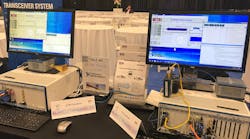Download this article in PDF format.
This past April, the fifth annual Brooklyn 5G Summit convened at the New York University (NYU) Tandon School of Engineering in Brooklyn, N.Y. The focus was on the latest developments in the realm of 5G communications, which was brought into view through various talks and panel discussions. In addition, the exhibition featured several companies that demonstrated impressive technology.
One demonstration was hosted by National Instruments (NI) in conjunction with W2BI. Together, the two companies displayed an end-to-end 28-GHz test system that can emulate both the 5G network and the user equipment (UE). The test system integrates radio software layers with NI’s mmWave transceiver system to enable end-to-end, over-the-air (OTA) 5G testing. One of the two PXI chassis represents a base station (gNodeB), while the other represents a UE (see figure).
This 28-GHz test system offers end-to-end capability, emulating both the network and the UE.
James Kimery, director of marketing for RF, communications, and software-defined radio (SDR) initiatives at NI, was present to talk about the demonstration. “The physical layer on both sides (network and UE) was provided by NI and written in LabVIEW. What W2BI has done is integrate upper layers of the protocol stack. What that does is simulate the interaction between a UE and a base station at a very high level. This is almost exactly what 5G will be.
“The physical layer is a very close approximation of what the 5G New Radio (NR) physical layer will be. The upper layer is the closed-loop control of that communication. In this system, we have a phased-array antenna and a horn antenna. It is demonstrating some of the concepts of being able to switch the beams of both the transmitter and receiver to be able to get some characteristics of the beams themselves. And because the system can run the protocol stack, the physical layer can be controlled at a very high level.”
Kimery also pointed out that the test system offers closed-loop control capability. “This system offers closed-loop control, meaning it’s actually doing what a real base station or UE would do. The software itself is embedded in the FPGA physical layer platform and it runs real-time.”
Another significant aspect of the overall test solution is the phased-array module, which Kimery explained in more detail. “This technology was developed by Ball Aerospace in conjunction with Anokiwave. This is one of the only systems I’ve seen that has a phased-array antenna inside a test simulator.”
The headline of this year’s Brooklyn 5G Summit was “Ready for Takeoff.” The latest developments in the 5G world—such as what was described here—showed why 5G may soon indeed be ready for takeoff.


